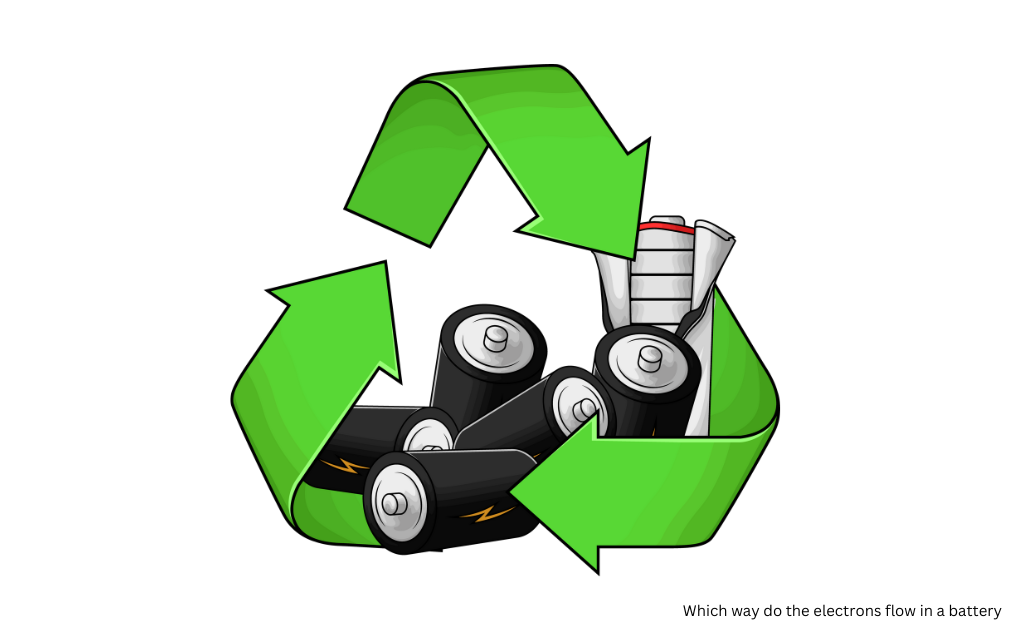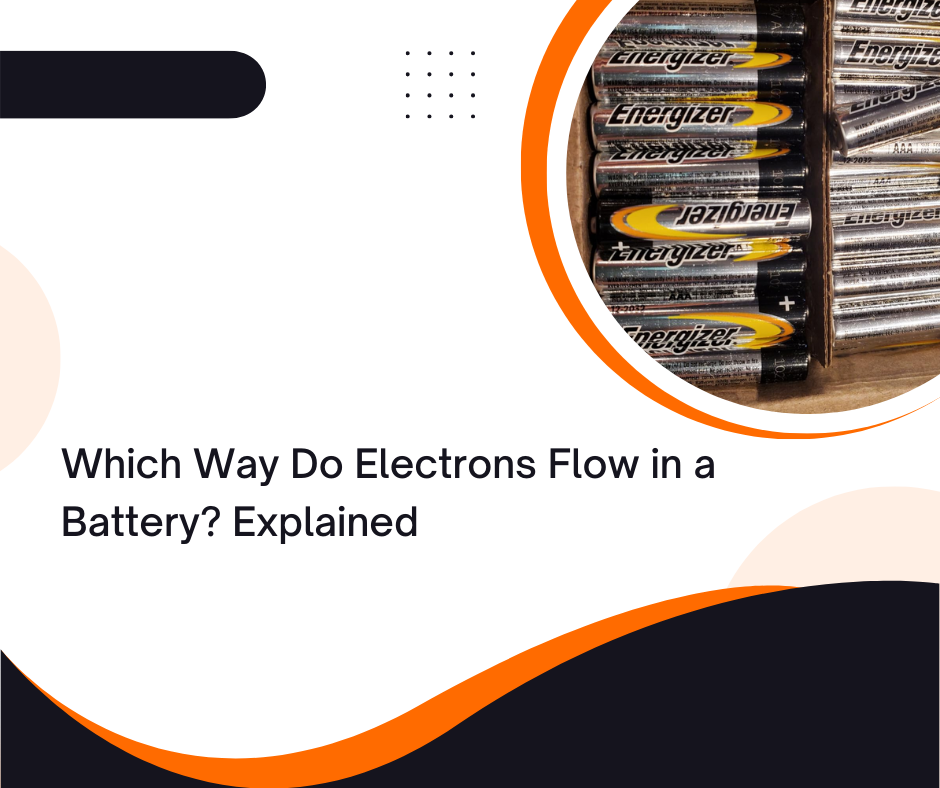Have you ever wondered how a battery powers your phone, flashlight, or remote control? You insert the battery, press a button, and suddenly, it works. But have you ever stopped to think—which way do the electrons flow in a battery?
Many individuals base their understanding that electricity conduction starts in the positive terminal and ends in the negative. The actual electron flow direction runs in the opposite direction compared to popular assumptions. School textbooks along with circuit diagrams frequently display current flow in an direction that is opposite to the actual movement of electrons. So, what’s the truth?
We’ll break down the science behind electron flow in simple terms. You’ll learn how a battery works, the difference between conventional current and electron flow, and why this matters in real-world applications. By the end, you’ll have a clear understanding of how electrons move through a circuit.

Understanding Electricity: How Do Electrons Move?
To understand how electrons flow in a battery, we first need to explore some basic electrical concepts. Many people think electricity moves in a straight path, but there’s more to it. Let’s break it down step by step.
Electric Current vs. Electron Flow
Electric current is the movement of electric charge through a conductor, like a wire. It’s measured in amperes (A) and is essential for powering devices. However, there’s a common mistake people make—current flow is not the same as electron flow.
Think of a busy road. Electronic charges appear as cars while electric current behaves like moving street vehicles. The moving vehicles form one specific direction despite traffic reports that could outline the flow pattern differently. The same happens with electricity.
Two Different Paths: Conventional Current vs. Electron Flow
Long ago, scientists believed electricity flowed from positive to negative. This became known as conventional current flow. Even today, many circuit diagrams and textbooks use this direction.
However, when scientists later discovered electrons, they found that electrons actually move from negative to positive. This is called electron flow.
So, which one is correct? Both are used, but electron flow is the real movement of charged particles inside a wire or circuit.
Why Do Electrons Move?
Electrons carry a negative charge. They are naturally attracted to the positive terminal of a battery. Imagine a magnet pulling small metal pieces—electrons behave in a similar way. The negative terminal (anode) pushes electrons away, while the positive terminal (cathode) pulls them in. This movement creates the flow of electricity.
Understanding this difference helps in learning how batteries power everyday devices. Now that we know how electrons move, let’s explore how a battery makes this possible.
How a Battery Works: The Key Components
A battery might look simple, but it’s full of complex parts working together to create power. Let’s take a closer look at how it all fits together.
The Anode: The Negative Side
The anode is the negative terminal of the battery. It’s where electrons are stored and waiting to move. Think of the anode as a parking lot for electrons. They’re stuck there, ready to race out into the circuit when the battery is connected.
The Cathode: The Positive Side
On the opposite end of the battery, you’ll find the cathode, or the positive terminal. This is where the electrons are heading. The cathode is like the finish line, pulling the electrons in because it’s positively charged.
The Electrolyte: The Helper
Between the anode and cathode, there’s a substance called the electrolyte. It’s a special chemical that helps move ions (charged particles) from one side to the other. The electrolyte acts like a bridge, allowing ions to travel inside the battery while keeping the electrons in the external circuit.
Think of It Like a Water Slide
Imagine you have a water slide with two ends: one side is higher (the anode) and the other is lower (the cathode). When water (like electrons) starts sliding down, it’s pulled toward the lower end. The electrolyte is like the water, helping the flow happen smoothly.
In simple terms, the anode pushes electrons out, and the cathode pulls them in, while the electrolyte helps everything move in the right direction. This movement of electrons creates the electrical current that powers our devices.
Which Way Do Electrons Actually Flow in a Battery?
Now that we know what a battery is made of, let’s answer the big question: Which way do electrons actually flow?
Batteries are essential power sources in modern electrical and electronic applications, yet the flow of electrons within them remains a topic of curiosity and misunderstanding. To clarify this concept, we must examine the internal workings of a battery and the principles governing electron movement.

The Real Path of Electrons
In a battery, electrons flow from the anode (negative terminal) to the cathode (positive terminal) through the external circuit. To put it simply, electrons leave the negative side of the battery and move towards the positive side. This flow of electrons is what creates the electric current that powers your devices.
Why It’s Opposite to Conventional Current
You might wonder, if the electrons flow from negative to positive, why do we say electric current flows from positive to negative? This is where things get a little tricky.
A long time ago, scientists didn’t know about electrons, so they assumed current flowed from the positive terminal to the negative one. This idea became known as conventional current flow. Even though we now know electrons flow the opposite way (negative to positive), we still use conventional current flow in most diagrams and explanations.
Visualizing the Flow of Electrons
To make this clearer, imagine a simple flowchart:
- Anode (Negative Terminal): Electrons build up here, waiting to move.
- External Circuit: Electrons flow through the wire, moving toward the positive terminal.
- Cathode (Positive Terminal): Electrons are pulled in here, completing the circuit.
This movement of electrons from the negative to the positive terminal powers everything from your phone to your flashlight. It’s the backbone of how electricity works in batteries!
How Understanding Electron Flow Helps in the Real World
Knowing how electrons flow in a battery isn’t just a fun science fact—it actually matters in real-world applications like circuits, electronics, and energy storage. Let’s look at how this knowledge impacts some of the most common technologies we use today.
Electron Flow in Circuits and Electronics
Knowledge of electron flow patterns allows engineers to develop improved circuit designs for all electronic devices that include smartphone and TV remote controls. A controlled electronic flow of electrons makes devices operate more effectively. People without understanding of electrical flows would make circuits much less dependable and trigger device malfunctions.
Rechargeable vs. Non-Rechargeable Batteries
The way electrons flow also plays a role in rechargeable and non-rechargeable batteries. In a non-rechargeable battery, electrons flow only once, from the negative to the positive terminal, until the battery runs out of power. You throw it away when it’s done.
On the other hand, rechargeable batteries can send electrons back and forth many times. This is because they use a special chemical process that allows the battery to be “refilled” with energy. Knowing how electrons flow in these batteries helps make them last longer and work more effectively.
Energy Storage in Renewable Technologies
Electron flow also plays a key role in renewable energy storage, such as in solar panels and electric vehicles. In solar panels, sunlight creates an electron flow that can be stored in batteries for later use. This stored energy powers everything from homes to electric cars.
In electric vehicles (EVs), the battery stores energy and sends it out in the form of electron flow to the motor, powering the vehicle. Without understanding how electrons flow, these modern technologies wouldn’t be possible.
So, whether you’re using a smartphone, driving an electric car, or storing solar energy, knowing how electrons move is at the heart of many technologies that power our world today.
Clearing Up Common Confusions About Electron Flow
You might have seen diagrams in textbooks showing current flowing from positive to negative, but that doesn’t match the way electrons actually flow in a battery. So, why does this happen, and does it matter? Let’s clear up some common misconceptions.
Why Do Textbooks Show Current Flowing from Positive to Negative?
It became a conventional practice in textbooks to show current movement as a positive to negative process. Scientists originally believed positive charges were the force that transferred electricity through the circuit. Scientists accepted this notion before they found the electron because it carries negative charge. The scientific community continues to keep the established convention of illustrating current flow from positive charges to negative ones even though modern knowledge proves electrons actually travel in the opposite direction.
Why Do Some People Think Electrons Move the Other Way?
It’s easy to get confused because people are often taught the conventional current direction, not the actual electron flow. Also, since most of us see electrical diagrams with the current going from positive to negative, it’s natural to think that’s how the electrons move too. But remember, electrons are negatively charged, so they flow in the opposite direction—from the negative terminal to the positive terminal.
Does This Affect How We Design Electrical Systems?
Surprisingly, this confusion doesn’t affect how electrical systems are designed. Engineers still design circuits based on the actual electron flow (negative to positive). The use of conventional current is just a way to make things simpler in communication and learning. In practice, electrical systems and devices will work the same, no matter which direction is used to represent current flow.
In short, understanding that electrons flow from negative to positive helps clarify the science, but the overall design and operation of electrical systems remain unaffected by this difference.

Frequently Asked Questions About Electron Flow
1. Which way do electrons flow in a car battery?
In a car battery, electrons flow from the negative terminal (anode) to the positive terminal (cathode). This flow happens through the car’s electrical system, powering everything from the starter motor to the lights.
2. How does a battery lose charge over time?
A battery loses charge when electrons move from the negative terminal to the positive terminal. Over time, the chemical reactions inside the battery can slow down, causing the battery to lose its ability to hold a charge. Eventually, the battery can no longer power your device.
3. What happens to electrons when a battery dies?
When a battery dies, the chemical reactions stop working. As a result, electrons can no longer flow from the negative to the positive terminal. The battery is no longer able to produce electrical current.
4. Do electrons always flow in the same direction?
In most cases, electrons flow from negative to positive in direct current (DC) circuits. However, in some circuits, like alternating current (AC), the direction of electron flow can change regularly, switching back and forth.
5. Does electron flow change in AC vs. DC circuits?
Yes, electron flow changes in AC and DC circuits. In a DC circuit, electrons flow in a single direction, from negative to positive. In an AC circuit, electrons move back and forth, constantly changing direction. This back-and-forth flow allows AC to travel over long distances more efficiently.
Wrapping It Up: Understanding Electron Flow
To recap, electrons always flow from the negative terminal (anode) to the positive terminal (cathode) in a battery. This movement is essential to powering devices and making circuits work.
Understanding electron flow is more than just a science fact—it helps in electronics, engineering, and even in daily life. Whether you’re using a phone, driving a car, or learning about renewable energy, this knowledge makes technology work smoothly.
By knowing how electrons flow, we can design better devices, improve energy storage, and create more efficient systems for the future. So, next time you plug in your device or jumpstart a car, remember—it’s the flow of electrons making it all happen!
